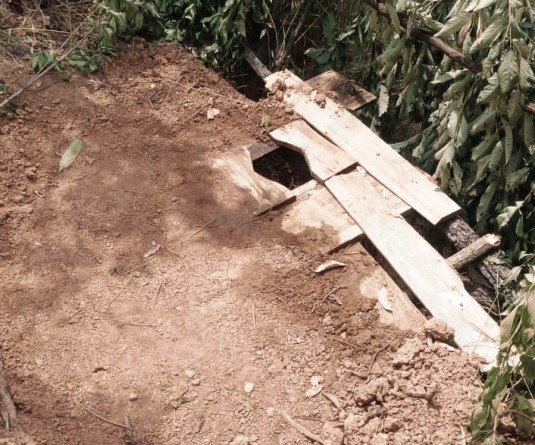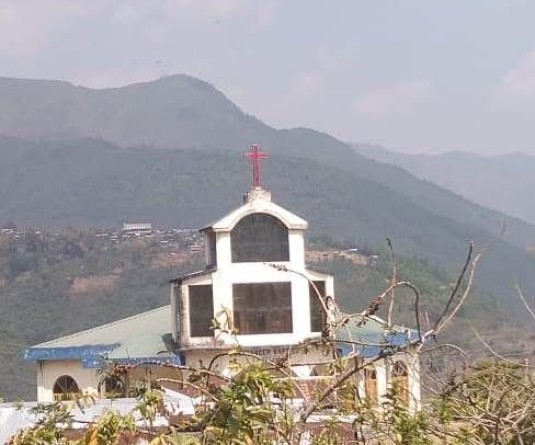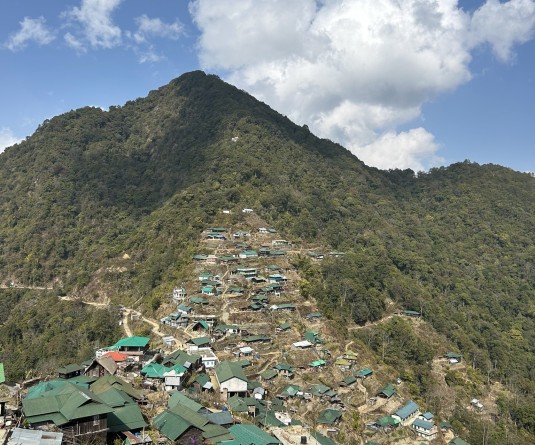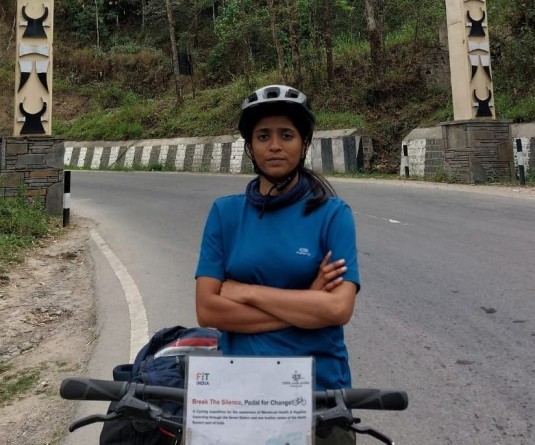Justice delivery in Nagaland: Robust prison, weak legal system?
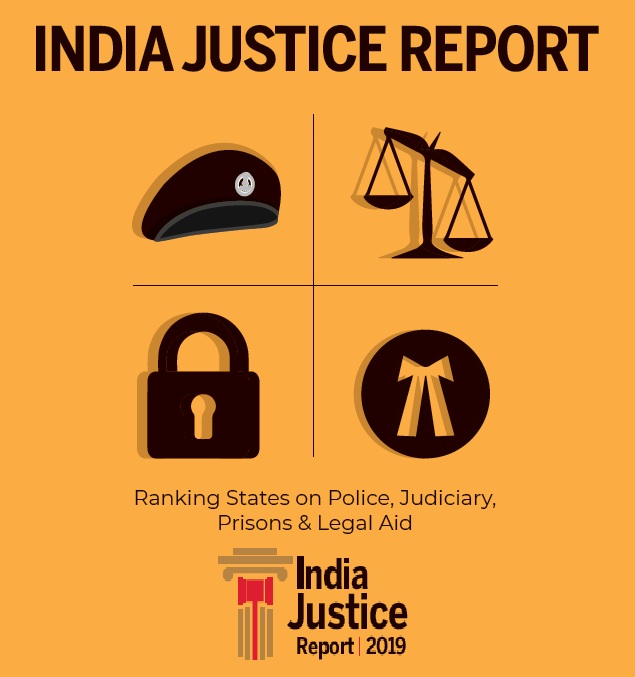
Morung Express News
Dimapur | November 12
The prison system in Nagaland, at least in terms of human resources and related parameters, is among the best in the country, according to the India Justice Report (IJR) 2019 released last week.
However, the state was found wanting in terms of legal aid and judicial infrastructure for its citizen.
IJR, an initiative of Tata Trusts in collaboration with the Centre for Social Justice, Common Cause, Commonwealth Human Rights Initiative, DAKSH, TISS- Prayas and Vidhi Centre for Legal Policy, is described as India’s first ever ranking of States on their capacity to deliver Justice to citizens.
Prison Management
The prison system is reflected to be robust in the report. For instance, the number of inmates per cadre staff (head warder, warder and other jail cadre staff including clerks was lowest in Nagaland – one per cadre staff). At 27 inmates per staff, Jharkhand had the highest ratio.
The Model Prison Manual (MPM), 2016 suggests a maximum of 6 inmates per cadre staff, the report said. While these ratios seem reasonable, they do not take account of the fact that the inmate per staff ratio has to be calculated as three eight-hour shifts for a full day job, it noted.
Again, in terms of prison officers (Director General to Assistant Superintendent Rank) per inmate, Nagaland has the lowest ratio at 11 per officer. Jharkhand presents the highest ratio at 343 inmates per officer, followed closely by Uttar Pradesh at 304.
Seen as a trend (2013–2017), among the ranked states, Kerala, Bihar and Gujarat are the only states to have consistently reduced the number of prisoners per prison cadre staff and officers, the report added.
Further, the MPM 2016 prescribed for one correctional officer for every 200 prisoners and one psychologist/counsellor for every 500. Only Odisha (124) and Nagaland (28) were below this figure.
Among the large and mid-sized states, this figure was above 95,000 inmates per correctional staff in UP, followed by Gujarat with more than 12,000. Among the small states, Mizoram had the highest ratio of inmates per correctional staff at 1,161, while Himachal Pradesh had the lowest at 548.
Diversity
According to the IJR, out of more than 433,000 inmates across the country, nearly 18,500 were women.
Here too Nagaland had the highest percentage in terms of women staff at 22.87%. Only five other states and UTs—Sikkim (18.82 %), Karnataka (18.74%), Arunachal Pradesh (18.18%), Meghalaya (17.05%) and Delhi (15.18 %) have more than 15% women staff. Goa and Telangana have only 2.2 % and 2.3 % women in prison staff respectively.
In policy documents, the suggested percentage is 33%, the IJR report informed.
Nationally, more than half (56%) of all women are clustered into the guard or warder category, followed by 12 % at the ministerial non-gazetted levels.
At the senior level, women are few and far between, and there are just 272 women jailors and women officers of the rank of deputy superintendent across the country, the report said.
Regarding women in the prison service, the year-to-year trend between 2012 and 2016 shows negative growth in Mizoram, Bihar, Chhattisgarh, Andaman and Nicobar Islands, Manipur, Daman and Diu, Goa, Nagaland, Kerala and Tripura.
Maharashtra had an increase of 1.4 percentage points while Odisha, Tamil Nadu and Rajasthan showed a marginal increase.
As of December 31, 2016, the nationwide occupancy rate stood at 114%. Nagaland was among 12 states and 5 UTs having had fewer prisoners than accommodation. It ranges from 20.5% in Nagaland to a staggering 222.5% in Chhattisgarh.
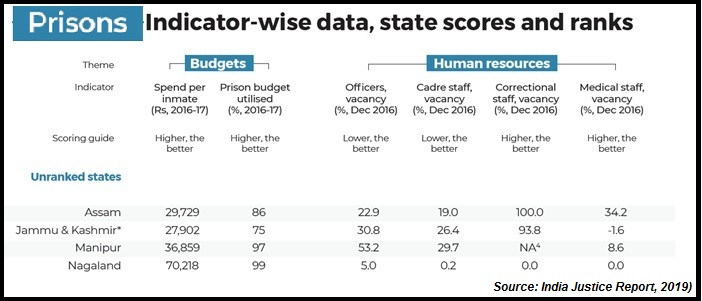
Other parameters
Meanwhile, in terms of spending per inmate, the IJR informed that the amount was highest in Nagaland at Rs 70,218 (2016-17).
There was also 99% utilisation of Prison budget while officer vacancies as of December 2016 was mere 5% while cadre, medical and correctional staff vacancy was nil during the same period.
As far as constabulary is concerned, as of January 2017, amongst all the states, Kerala, Nagaland and Tamil Nadu were the only ones that had reached the sanctioned strength.
In terms of utilisation of Union Ministry of Home Affairs police’ Modernisation Scheme to assist state forces in meeting capital expenditures, like the construction of new buildings and availing technology and better equipment, Nagaland was the only state with 100% utilization of the grant, according to data for 2016–2017.
However, few misses
While in terms of workforce and capacity, the prison system seems robust, the outcomes in some areas, however, were weak. According the IJR, the prison departments of Bihar, Karnataka, Chhattisgarh, Nagaland, Tripura and Telangana had no collated data to provide and instead pointed the researcher to district level offices, without any information about who the responsible “public information officers were or let alone their contact details.”
Telephone numbers too were often incorrect: illustratively, those of the Tamil Nadu Prison Department, Nagaland DGP office, SLSA of Jharkhand, and Bihar DGP office.
Since 2012, there has been an emphasis on appointments for full-time secretaries to district legal services authorities (DLSAs). Across India, against 664 DLSAs, the number of sanctioned posts of full-time secretaries to DLSAs stood at 603—a deficit of 61.
The number of full-time secretaries in place was 525—a deficit of 139 to the number of DLSAs.
As of 2019, smaller jurisdictions such as Arunachal Pradesh, Mizoram, Sikkim, Andaman and Nicobar Islands, Dadra and Nagar Haveli, Nagaland, Daman and Diu, Puducherry, Lakshadweep are yet to sanction full-time posts. A possible reason for this may be a shortage of judicial officers.
The number of legal aid providers varies a great deal across states, and no uniform or standardized policies exist for regulating the number of appointments.
As of January 2019, there were 63,759 panel lawyers and 69,290 paralegal volunteers (PLVs) working with LSIs across the country. As per NALSA’s Para-Legal Volunteers Scheme every DLSA should ideally have 50 active PLVs amounting to at least 33,200 PLVs across 664 DLSAs.
Nagaland was among the nine states with less than the required numbers—(165/550).
Nagaland with 8.9 PLVS per lakh population was one of twenty-two states/UTs with less than 10 PLVs per 100,000 population. States like Arunachal Pradesh (77.0), Himachal Pradesh (84.3) while at the lower spectrum were Dadra and Nagar Haveli having the least (0.9), followed closely by Uttar Pradesh (1.6).
Paralegals are a vital link between the LSI and the community, as well as an important resource embedded within it, it noted.
In 2017–2018, six states and UTs including Jharkhand and Assam had no funds allocated from the state, whereas Nagaland, Arunachal Pradesh, Manipur, Tripura saw less than 20 % being provided by the state governments. Uttar Pradesh and Andhra Pradesh on the other hand saw more than 80 % coming from the state governments.
In terms of reservation for SC and OBC in police force, the report quoting BPR&D data informed that the state had none in both. However, given the composition of the population, this can be rationalised. There was also no data on pending cases 5-10 years and 10 years above in subordinate courts for Nagaland and Arunachal Pradesh.
Overall Data
According to a press release from Tata Trusts regarding the IJR 2019 on November 7, Maharashtra topped India’s first ever ranking of States on their capacity to deliver Justice to citizens among 18 Large and Mid-sized States (with population of over one crore each), followed by Kerala, Tamil Nadu, Punjab and Haryana. The list of seven Small States (population less than one crore each) was topped by Goa, followed by Sikkim and Himachal Pradesh.
But even the best performing states have been unable to score even 60% in their performance on capacity across Police, Judiciary, Prisons and Legal aid, the release said.
The report was prepared through an 18-month quantitative research.
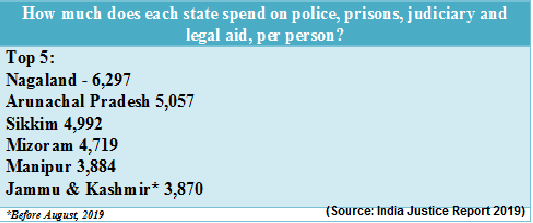
Nagaland among ‘States of exclusion’
Morung Express News
Dimapur | November 12
The India Justice Report (IJR) omitted four states - Nagaland, Manipur and Assam in the north-east of India and Jammu and Kashmir* (pre-August) from the overall ranking.
In a explanatory note, Sanjoy Hazarika, International Director, Commonwealth Human Rights Initiative, part of the research team, explained that in those states “there exists, or have existed for some time, either acute or significant challenges of internal security, going beyond the normal ambit of policing and law and order.”
“This is deliberate, as the conditions that exist in these states mean that normal policing processes, or even special use of civil force (i.e. declaration of Section 144 CrPC to deny the gathering of more than four persons, or even periodic curfews) prove inadequate in dealing with local condition,” he noted.
As a result, local administrations have resorted to invoking extraordinary central laws which bring in the armed forces and, consequently, sweeping powers of shooting, detention and search without warrants.
In these four states, the law-and-order machinery is buttressed and even superseded in parts by extraordinary central laws like the more than sixty year- old Disturbed Areas Act (DAA) and the Armed Forces (Special Powers) Act (AFSPA) to handle internal disturbances.
Taken together, these four states spent an average of 10.48 per cent on the police, more than twice the average spent of much larger states in the large and mid-sized clusters in the report, Hazarike further informed. In 2015–2016, for example, data shows that Manipur spent the highest proportion of its budget on the police, followed by Punjab and Jammu and Kashmir.
“On the judiciary, however, the average spend was only 0.40 per cent—lower than the national average of 0.54 per cent—even though, arguably, the need for effective and efficient legal recourse and urgent remedy is greater in areas where exceptional situations exist,” he underscored.
“In such circumstances, the Justice Report team felt, it would not be appropriate to club these states with others where a more ‘normal’ force of criminal justice system was in place,” he elaborated on the exclusion.
Read the full report here:
India Justice Report: Ranking states on police, judiciary, prisons and legal aid


